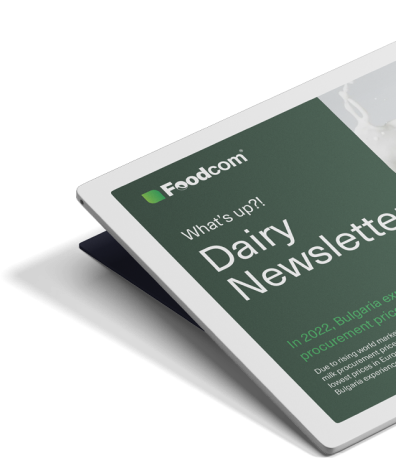Dairy ingredients with high purity and functionality, such as milk powder, protein isolates and concentrates or demineralised whey, are gaining increasing importance in the industry. What exactly is whey in this form, what technological properties does it have and where to order it? Let’s take a look at the types of demineralised whey available and its applications.
What is demineralised whey powder and how is it made?
Whey is a by-product of the cheese production process. It accounts for 50-60% of the milk solids, and is separated from the milk by separating the curds when an enzyme, rennet, is added to the milk. Although often treated as a by-product, whey has a high nutritional value, being a valuable source of lactose, protein, vitamins and minerals.
When properly processed by spray drying and demineralisation, whey can be obtained in powder form with reduced mineral content, known as demineralised whey.
The demineralisation process allows a certain percentage of minerals (mainly sodium, potassium, calcium and chlorine) to be removed – from around 40% to as much as 90%. As a result, the final product has a milder taste and is better tolerated by the body, which is particularly important for infant products or specialised diets.
Properties of demineralised whey – why use it?
Demineralised whey powder is distinguished by its favourable nutritional composition and functional properties that contribute to making it a valued ingredient in food and feed production. Its main advantages are:
- high nutritional values, in particular a high content of lactose and easily digestible whey protein with a low amount of fat;
- mild or neutral (with a high degree of demineralisation) taste;
- good water solubility and mixability with other ingredients;
- low hygroscopicity and high thermal stability and shelf life;
- ability to improve the texture and colour of final products;
- versatile application in a variety of industries;
- ability to tailor the product to the specifics of production (e.g. choice of demineralisation rate);
- low mineral content, absence of gluten and added sugar make whey safe and easily digestible, making it ideal for infants, children and people with sensitive digestive systems.
Types of demineralised whey
Depending on the degree of purification from mineral salts, there are different types of demineralised whey powder. Each of these can find use in different industries and technological processes. The most common variants are:
Demineralised whey powder 20-35%
This is a whey powder from which a small amount of minerals have been removed. It has a distinct flavour, making it mainly used in baked goods and fermented products, as well as in the production of milk chocolates and confectionery.
Demineralised whey powder 40%
Demineralised whey powder 40% is a product from which approximately 40% of the minerals have been removed. It is mainly used in the confectionery, bakery and dairy industries, especially in the production of chocolates and other confectionery. It has a mild taste, but still contains some minerals that affect the texture and taste of the final product.
Demineralised whey powder 50-70%
This is a whey powder with an intermediate level of demineralisation. It is often used in the ice cream industry and in the production of dairy drinks, as well as functional and speciality foods.
Demineralised whey powder 90%
Demineralised whey powder 90% is a whey that is characterised by a very low level of ash (the total amount of minerals in the product) and a neutral taste, making it an ideal base for speciality products with strict nutritional parameters. It is mainly used in the production of milk mixes for infants, medical and dietary foods.
The choice of the right type of whey depends on the end use, technological requirements and expectations regarding taste and nutritional value.
Use of demineralised whey
Owing to its properties, demineralised whey powder is used in many industries, especially in the food industry:
- in the dairy industry it is used as an ingredient in dairy drinks, yoghurts, desserts;
- it is used in the production of baby food (milk replacers);
- in the confectionery industry, whey is used to produce chocolates, bars or milk fillings;
- in bakery products, it has a beneficial effect on the texture and colour of baked goods;
- it is also used as an ingredient in food products for special purposes (diet, sports, medical);
- it is also used in the animal feed industry, especially in the production of feed for young animals (due to its high nutritional value, protein and lactose content).
Demineralised whey powder is a versatile dairy product with high functionality. Depending on the degree of demineralisation, it can be used in a variety of applications – from the production of confectionery to speciality and dietary foods.
If you are looking for a reliable source of whey powder in a variety of demineralisation options, it is worth visiting places such as the B2B e-commerce platform FDCM. It is a modern space designed for wholesalers or manufacturers who are looking for the highest quality raw materials. On the FDCM platform, it is also easy to order free samples that allow for quality and technology testing before placing a larger order.







